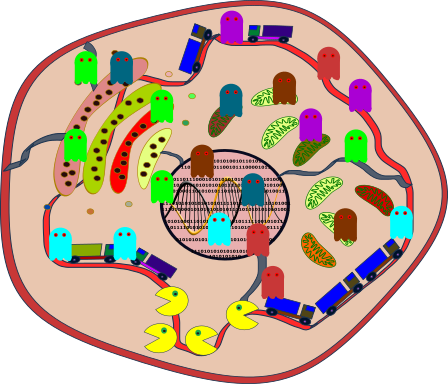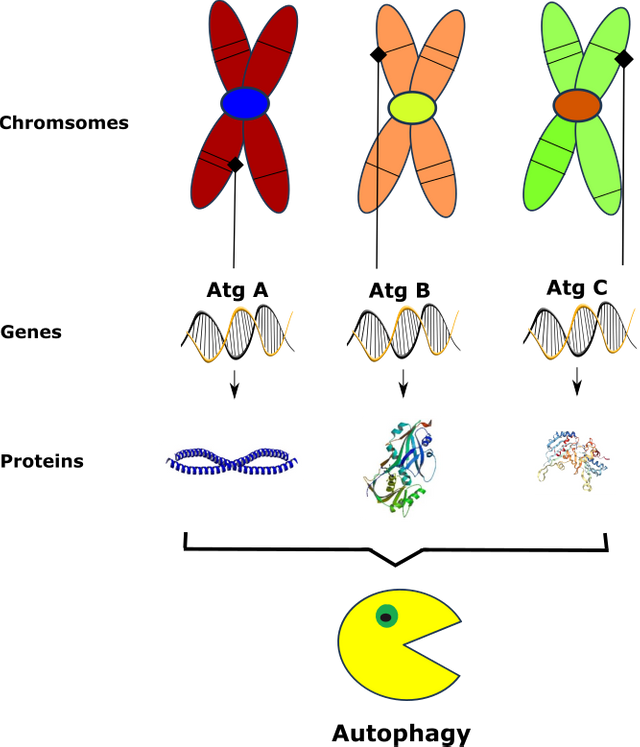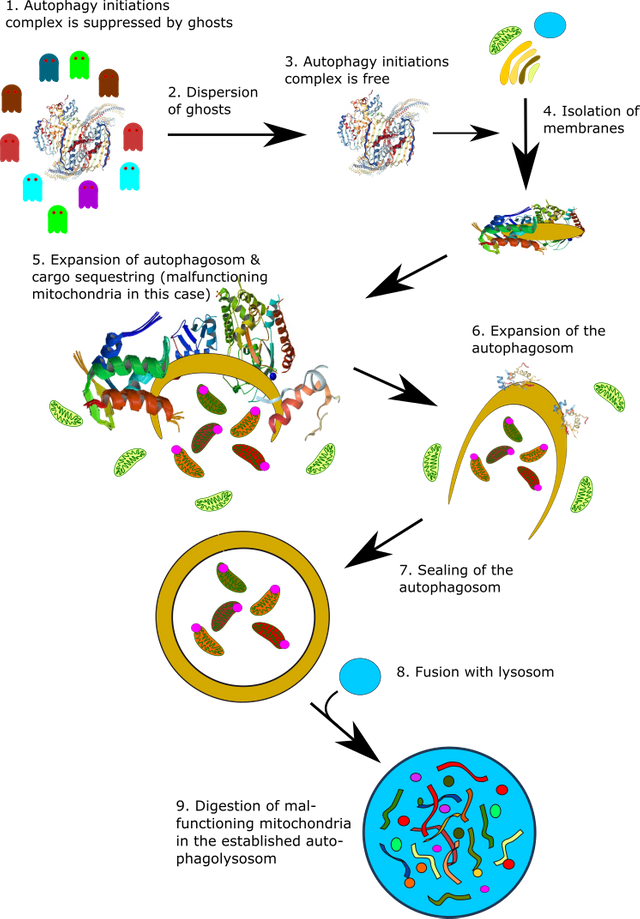Clean up your cells! The Best Protection Against Aging, Cancer, Alzheimer's disease & Co: 3. Autophagy: Tidy up your cells or do you live in your own filth at home?
Hello! Nice to see you back. Slowly but surely, we are getting further inside of our “life units”, our cells. But let’s start in our “real life” first. Everyone knows that maybe. You are getting constantly admonished to be neater and cleaner. Everything, your apartment, your desk, yourself must be shining and should be tidied up 100%. The funny thing is, that when it comes to cleanliness where it really would be appropriate, the most people don’t fit their own standards. I’m talking about your health and your body, your most faithful companion and most important treasure.
One maybe just in advance. Cell biology and physiology are extremely complex topics that are still not fully understood. This series of articles should give everyone the opportunity to enter these areas. If the article becomes too extensive, many people will probably lose the thread. Which is not in my interest. I would therefore ask all biology experts to look it up. I will consciously omit details just to give all people a glimpse. But in the future, it would be nice if we could also go into more detail, network and exchange the latest findings in this and other fields.
I think one of the most common problems for understanding in just about every area is that the vividness is missing. People are fed with many technical terms and complicated contexts without even having any idea what it is all about. For this reason, let's start with the most basic insights into cell biology. No matter what your teachers or whoever told you, each cell is basically comparable to the normal life around us. There are essential facilities in the cell, as well as in your city or your country, without which it simply would not work. The most important (among others) are:
- A device capable to manage the cell. This device must ensure that everything is in order, and this includes (in particular) the following tasks: the correct accounting, and error-free archiving of essential information in the form of a genetic code. As well as the recording, processing and sharing of information within the cell and beyond. If even one of these basic functions is disturbed, a suicide program (apoptosis) is carried out in this power center, called the nucleus, which destroys the cell to prevent bad degeneration.
- Units that ensure the production, distribution and quality management of the cell. The cell is basically made of fatty acids, cholesterol and proteins. All these building blocks must be present in sufficient but not inflationary amount. In addition, the correct structure, as well as their correct arrangement, operation and localization is eminent. The cellular logistic is under control of many different structures, but especially realized by the endoplasmic reticulum (ER), the Golgi apparatus, ribosomes, the chaperone system, various feedback cycles and other tools. If these things do not tell you anything, no problem, we'll come back to them within this article series and elsewhere in more detail.
- Closely connected with the logistics is of course a functioning infrastructure. This infrastructure enables the transport and distribution of proteins, fatty acids and other structures within the cell. In addition, the infrastructure is also involved inthe shaping and stabilization of the cell, as well as in the transmission of information. The most important representatives of this infrastructure are actin, tubulin, intermediary filaments and associated factors. The infrastructure will also encounter us more often.
- The most important thing for every living being is energy. Even though cells have different strategies to generate energy, by far the most important is the energy production via mitochondria. To be honest, I love these things. Temporarily, I’m working with these things to help people to identify the cause of their health problems and I can only advise you one thing: Take care of your mitochondria! These little helpers are responsible for more than 90% of your energy depending on cell type and person. Their optimal functioning is therefore the be-all and end-all in your life. Incidentally, mitochondria were originally bacteria that made themselves comfortable in our cells billions of years ago. But I want to skip this here because I will tell you more about it elsewhere. So just keep in mind: Mitochondria = Energy!
- Now we are coming to the structure which this article is about: Your waste disposal.
Imagine in your city, from one day to the next, there would be no more waste disposal. Unfortunately, this is reality for many people on earth and nobody seriously want to be freely in a situation like this. The wastewater system, environmental protection and recycling are also part of an efficient waste management and are directly correlated with your quality of life. All of these, supposedly trivial things are so essential to us that if one or more of these factors will be vanished, daily life stagnates first, then resigns and finally collapses. This is well known to each of you, and therefore no one would easily accept the lack of a functioning waste disposal system. But what if I tell you that the majority who reads this article right now and would not tolerate the garbage that is left in front of their homes, at the same time, however, have no problem with the mess in their cells. But the dirt in your cells is not something you notice right away, you can live with it for years without having any problems with it. You have to be aware of that many of the health issues that have been brought to us by our progress, are mainly because your cells are totally filthy or not cleaned efficiently. In the next article about mTOR we will come closer to the causes. Nevertheless, one thing is to be said in advance: The cause of littering your cells is a permanent oversupply of nutrients and growth factors, as well as a disrupted rhythm in your life!. In a balanced way of life (we will discuss it in more detail in the fifth article of this series), the body is in a constant equilibrium between anabolism and catabolism. He can thrive, he can achieve progress and is full of power. At the same time, however, he manages to give himself the necessary freedom to cleanse. And these cleanups are essential because they ensure that
a) Your genetic information always has the best quality management and only spreads when everything is actually ready for it.
b) Problems in your logistics will be recognized and adjusted, so that nothing produces too much, nothing is blocked and nothing is wasted.
c) Along with this, as in real life, the infrastructure is maintained and repaired or rearranged so that traffic can always flow without any problems.
d) The power plants of your cells, the mitochondria, are repeatedly checked for efficiency and replaced in the case of serious failures. Incidentally, this is especially important, because your mitochondria start to produce radicals in case of disruption (we'll go back to that at a suitable point). In any case, these radicals in excess destroy everything, regardless of whether proteins, fatty acids or even DNA, so that the cell in question either dies or degenerates.
Do you remember the Packman analogy in the first article of this series? You are certainly aware that the Packman in our case represents the waste disposal system. The problem is that Packman can only work if he is not permanently hindered by ghosts. For this, however, the cell must come into a state where our cellular Packman can first build up undisturbed. Unfortunately, the problem is that the total chaos which triggered by an uncontrolled ghost invasion, prevents Packman to properly establish himself in the cellular environment. He appears here and there, but ultimately the ghosts prevent him from completely sweeping through the cell to do his work. The result: loss of genetic stability & control, stagnation & collapse of logistics & infrastructure, as well as disaster in your cellular power plants. So, before Packman can do his job, it must be ensured that the ghosts are restrained in their activities and this can only be guaranteed by one and that is you and your lifestyle!
The ghosts in your cells are a consequence of bad diet, exposure to toxins and pollution, as well as chronic stress. Of course, there are also genetic causes, but your lifestyle is something that everyone can influence and therefore, to a certain extent, you also have control over the ghosts. It's like setting the difficulty level in a computer game. You have the control over the menu, which determines in your cells whether your cells regenerate in a loose Packman game or if you always stuck until your cells have no more desire for the game. The consequences are an increased risk of diabetes, faster aging, increased susceptibility to cancer, too little energy and thus poor performance in daily life. In addition, poor sleep, increased risk of neurodegenerative diseases such as Alzheimer's or Parkinson's, bad skin, bad mood. The list of bad things can go on forever.
But how does this Packman arise in us? Representing the mechanism of autophagy, our cellular Packman is a genetic program designed to ward off stress, recover valuable resources, and prevent harmful developments such as degeneration, cell death, or the excessive formation of radicals. Dozens of genes, especially the so-called Atg's (autophagy-related genes) are involved. Genes, in turn, are defined as the sequence of information in the DNA (base sequence) whose use causes the formation of biologically active molecules. Such biologically active molecules are above all proteins (but also RNA, more about this elsewhere) and especially the enzymes. Atg's encode, for their part, especially for very special enzymes and these enzymes ultimately build the Packman together.
But it is important to know that the ghosts do not allow this easily. Not only do they prevent the assembly of Packman, they also interfere with his work and even prevent the reading of assembly information at the level of chromosomes (DNA). The exciting thing about this process is, incidentally, that the genes for autophagy are encoded on several different chromosomes. If I have counted right, then these genes (≥33) are scattered on at least 14 chromosomes. Nevertheless, in the end, everyone plays together in an orchestra to make the Packman or autophagy possible. But what exactly is this Packman? Essentially, our cellular Packman is a kind of vacuole, as we have already seen in the second article. This "special vacuole" is also referred to as autophagosysosome and is in principle a fat drop, which results from the cooperation of numerous proteins (see the next figure).
As seen in the picture, our Packman is able to eliminate a few flawed mitochondria. These broken mitochondria (in the form of free radicals) produce, beside of bad air, little or nothing useful for us. They are toxic and a serious threat for the cellular health. This process, called mitophagy, is one of the few well-understood selective autophagy mechanisms. Packman can also act in a non-selective way, sliding just across the street to collect random garbage. A true all-rounder if you want. In essence, all which is required is that the initial complex (a large complex of different Atg proteins), which is besieged by the ghosts, can act freely. As soon as he has been able to break away from the ghosts, the initial Atg protein complex grabs membrane fragments (small pieces of fatty acids) and recruits additional Atg proteins to this initial membrane. These additional proteins then cause an enlargement of the membrane and mediate the uptake of potential autophagy victims. More and more, these proteins cause the progressive enlargement of this so-called autophagosome, as well as the recruitment of victims. As a result, more and more doomed victims are trapped until finally a closed droplet with garbage inside is created. This droplet (the autophagosome) finally fuses with a so-called lysosome (also a greasy droplet) to create the autophagolysosome. In addition to its acidic interior, the lysosome carries a plenty of other enzymes which are feasible for breaking down biological molecules. These enzymes (also called hydrolases) eventually digest the collected waste, like the damaged mitochondria in our case. The remainings are not harmful to the cell anymore and can be used to generate energy or other tasks. So, now we have seen how this Packman emerges, what he really is, what he basically does and where he has his difficulties. But we have not heard anything yet about Packman's hardest opponent "The Ghosts". In the next article, we will have a closer look on “The Ghosts” and in the last article, we will then judge how to deal with both.
Thank you so much for reading this far. I hope we see each other again in the next articles. If you also have some great posts on the subject, please let me know.
See you in the next article
Greetings
Chapper
References:
The picture with the individual organizational units of the cell, as well as the picture with the Ghost Invasion, I have made by myself and can be freely used without hesitation. But it would be nice if you could quote this article here. Thank you very much 😉
The DNA, the waste symbol, as well as the electricity sign in the first two images are from Pixabay and can also be used freely. 1
2 3
The two pictures in which Packman is formed, I have also homemade, but the proteins shown by Protein data base, which is why they should be separately linked.
If you want to read further on the topic, then just have a look at the following articles or ask me directly.
Jan Osterkamp; Nobelpreis für Physiologie oder Medizin: Abfallcontainer für den zellulären Recyclinghof; Spektrum der Wissenschaft 12.16; S. 25-26
Bill Gifford; Gerontologie: Der Methusalem-Effekt; Spektrum der Wissenschaft 2.17; S. 42-49
Marino, G., et al., Self-consumption: the interplay of autophagy and apoptosis. Nat Rev Mol Cell Biol, 2014. 15(2): p. 81-94.
Dikic, I. and Z. Elazar, Mechanism and medical implications of mammalian autophagy. Nat Rev Mol Cell Biol, 2018. 19(6): p. 349-364.
Concerning the Atgs, check out this
Have Fun




I loved your posts and your unique style of describing the cells. I had my doubts that you are a biologist. Looks like I was right. Happy to see more people from the field communicating science in a brilliant way on this platform. I suggest you join @steemstem community as well. It is an initiative on steemit to promote good science writers. You can checkout the steemstem discord channel here https://discord.gg/HG7fwn
Hello Scienceblocks, thank you for your kind response. And yes you are right, I am actually a biologist. My goal is to bring as many people as possible closer to biological topics. Often I feel people are not interested in it because it's just too abstract for them. For example, when I was still working at the university, many of my biochemistry students could not even explain what a gene is. I think that's not because people are too stupid. Rather, I think that everything is over complicated and therefore unattractive.
Also, thank you for bringing my attention to Steemstem. I am new to Steem, but more and more I find more and more interesting blogs.
Hope I hear more from you soon.
Best regards
Chapper
Oh, by the way, I just saw that the link to the Discord Channel has gone out. Could you send me the new link?
Thank you very much and see you soon
We are waiting for you!
Keep it original and fun to read and you will have all sorts of people reading it. Engage with others and you will see many other people working in your field or close other fields. Plus, SteemSTEM has interesting plans with the science community and it's fun as we get to dictate what the community is like :D

https://discord.gg/AQ3UxVH
There